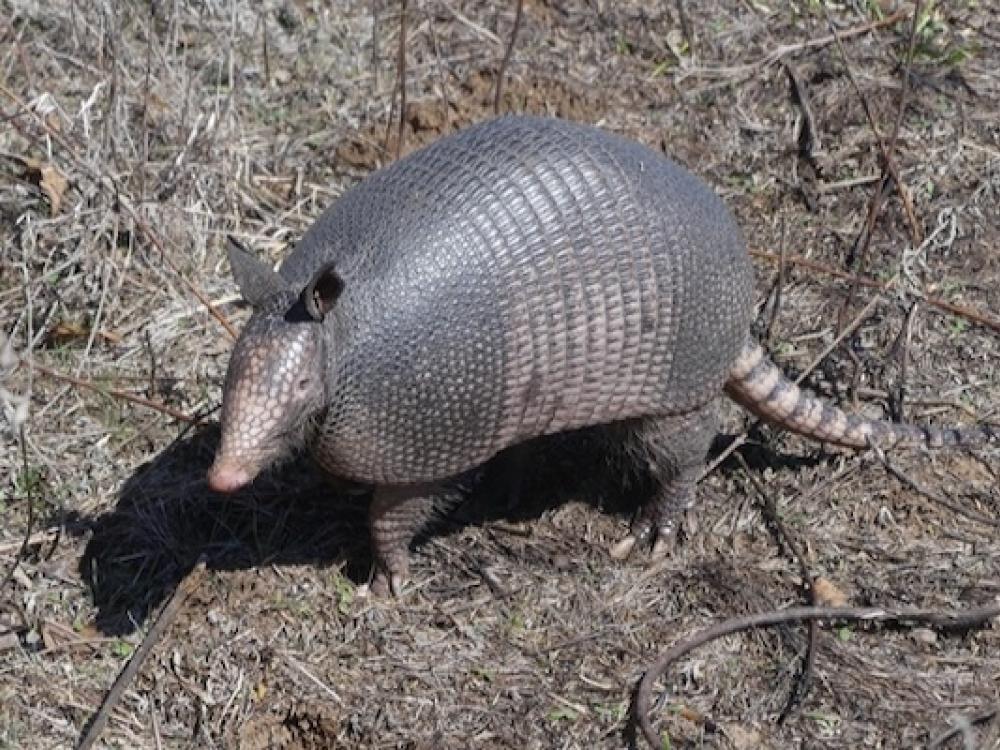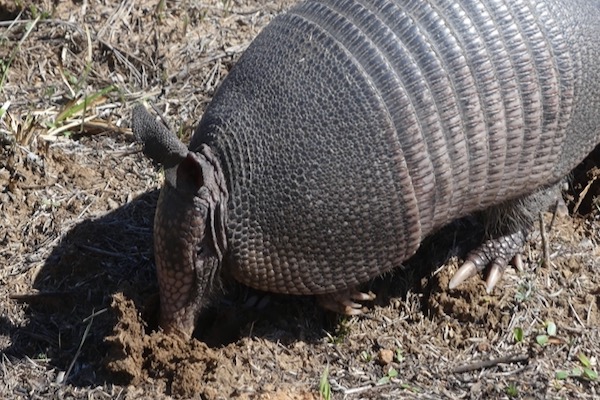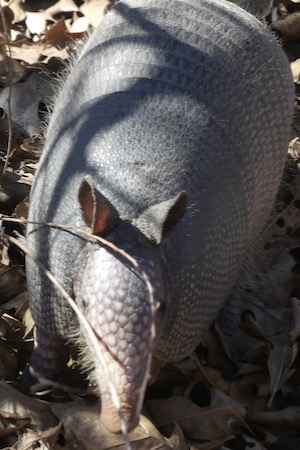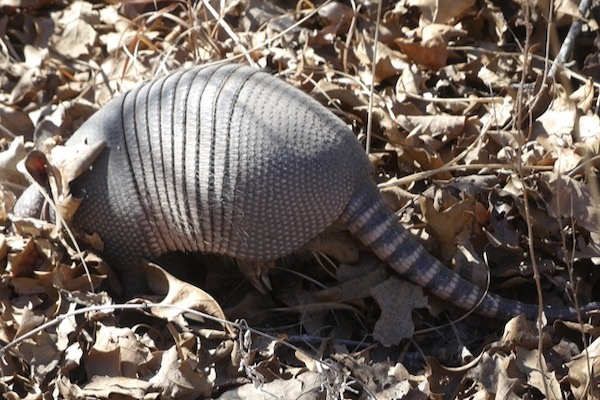
A nine-banded armadillo seen at LBJ National Grasslands. Photo by Michael Smith.
Feb. 17, 2023
They're an icon of Texas culture — duly designated the “official small mammal of Texas” by the 74th Legislature in 1995.
But decades before that, they shot into the spotlight, following the release of country singer Jerry Jeff Walker’s 1973 Viva Terlingua. In the album's big hit, London Homesick Blues by Gary P. Nunn, it was the armadillo who symbolized the Texan's longing for home.
Armadillo, which conveniently rhymes with Amarillo, is a Spanish word, which means the “little armored one.”
You’ll find her wandering the prairies and woodlands of the Lone Star State, digging grubs and bugs for dinner. She has a keen sense of smell, which helps make up for her poor eyesight.
If you’re walking in the woods and step into a hole, you might have discovered her front door.
Unfortunately, many Texans know these nocturnal creatures only as roadkill, a tragedy that happens when the near-sighted critters wander on the roads at night.
Every Texan ought to be acquainted with the armadillo.
Specifically, we should know the nine-banded armadillo, the widest-ranging species within the armadillo clan.
ARMADILLO 101
The nine-banded armadillo is instantly recognizable by their covering of armor, all the way from the head to the tail. Around their shoulders hangs a tough cape of thickened skin with little bony plates (osteoderms) embedded in that strong but flexible skin.
A similar shield of armor is wrapped around the hips and back legs. Those two protective shields are joined by several bands of similar material ,connected by skin to allow for movement. (Think of an accordion.)
 An armadillo digging for insects or other food. Photo by Michael Smith.
An armadillo digging for insects or other food. Photo by Michael Smith.
Usually there are nine of those bands, but occasionally there might be eight or as many as 11. (I guess not every armadillo reads the field guides.)
Even the top of the armadillo’s head and snout is covered with tough scales. Just below that covering are small, beady eyes.
As for their habits, the nine-banded armadillo can often be spotted with their nose to the ground.
According to Science magazine, they can sniff out insects up to 8 inches underground.
Their habit of digging up lawns might annoy some homeowners but the Texas Parks and Wildlife Department points out, they eat grubs, which also harm lawns.
Armadillos rely first on their sense of smell, then on the ability to hear, with vision being weakest.
The armadillo eyes’ lack light-detecting cells called cones, which give them fuzzy, colorless vision. Meanwhile, their light-receptive cells are so sensitive that daylight renders the nocturnal animals almost blind.
 Face-to-face with the armadillo. Notice the protective scales covering the head and snout. Photo by Michael Smith.
Face-to-face with the armadillo. Notice the protective scales covering the head and snout. Photo by Michael Smith.
If you’ve ever spent time around armadillos, you probably have witnessed them walk right up to a person, as if unable to distinguish the human from the surrounding environment. Occasionally they stand on hind legs as if sniffing the air.
To those who wonder if they bite — ever know anyone who was bitten by an armadillo?
I doubt that anyone ever has, partly because they are so nonaggressive and partly because they have little, peg-like teeth for chewing up delicacies dug from the ground. Their teeth would be nearly useless for defense.
Anyone who has grabbed an armadillo, or tried to, knows that they can buck straight up in the air — as much as a meter — when startled.
And they have powerful legs and large claws.
Those legs and claws make them amazing excavators. They dig burrows that may extend more than four feet (sometimes over 20 feet) and may have several branches. Usually there is just one entrance, but there can be a back door or side entrance. An armadillo may dig several different burrows and use each one periodically.
I talked with Fort Worth Nature Center and Refuge manager Rob Denkhaus about the armadillo’s digging skills.
“In North Texas, most any animal burrow that you stumble across, whether it contains a coyote, an opossum, or any other critter, started out as a hole dug by an armadillo in search of food or shelter,” he said.
RANGE

In the mid-1800s, armadillos were established in Texas. Photo by Michael Smith.
Nine-banded armadillos can be found all the way from South America, northward into an expanding range within the U.S. In the mid-1800s, they were established in Texas but no further. Since then, they have come to live all the way east to Florida and north to Missouri. See map.
If our climate keeps warming, how far north will the ‘dillo wander?
They seem to be limited by extended cold snaps and aridity — they need moisture, at least some ponds and creeks.
What’s on the menu for the armadillo?
Insects are the main course, including lots of adult and larval beetles. Ants and termites are also favorite foods (especially by South and Central American populations).
As the nine-banded armadillo wanders about, sniffing and digging in the soil and leaf litter, almost any small animal that it turns up may be eaten.
That includes the occasional small frog, lizard or snake. A little bit of plant material also winds up in the armadillo’s belly, perhaps by accident or on purpose.
Stomach contents can include mushrooms, berries and plums or grapes.
MEDICAL RESEARCH
Armadillos are among the very few animals that, along with humans, can become infected with leprosy (Hansen’s disease).
In North America, infected armadillos have been found only in Louisiana, Texas, Mississippi, and Mexico. Even in Louisiana, where the prevalence is greatest, no more than 10 percent of armadillos have the disease at any given time.
As a result, scientists are using armadillos to research into Mycobacterium leprae, the cause of leprosy. The bacterium cannot be grown in vitro, in the lab. However, the leprosy microorganism can easily live within armadillos because of the animal’s low body temperature.
Captive armadillos are now used in the study of the disease, a little known fact that might rile some animal advocates, including doctors who oppose the use of animals in medical research.
Can we get leprosy from nine-banded armadillos? An article in the Journal of the São Paulo Institute of Tropical Medicine describes the possibility of occasional transmission of leprosy from armadillos to humans, perhaps from eating the meat or from prolonged contact with captives.
The Centers for Disease Control and Prevention report that people cannot get leprosy from brief, casual contact with other humans. And they state that “most people who come into contact with armadillos are unlikely to get Hansen’s disease.”
QUAD MOM
 Armadillo mothers always gives birth to four genetically identical quadruplets. Photo by Michael Smith.
Armadillo mothers always gives birth to four genetically identical quadruplets. Photo by Michael Smith.
There’s another way that the nine-banded armadillo helps with medical research. Mama ‘dillos produce a single egg that, after it is fertilized, splits into four identical embryos. She always gives birth to four genetically identical quadruplets.
This presents an opportunity to study how genes are expressed and why there can be individual differences among, for example, human twins who inherit exactly the same genes.
THE TALE’S END
 Looking down the tail of an armadillo skeleton. Notice that the tail vertebrae attach to the covering of bony rings. Photo by Michael Smith.
Looking down the tail of an armadillo skeleton. Notice that the tail vertebrae attach to the covering of bony rings. Photo by Michael Smith.
Who knew armadillos had such complicated and interesting lives? A lot of our other-than-human neighbors have fascinating biographies.
A little digging can reveal beautiful details and deep mysteries about the wildlife that lives around us.
But remember — it's only the armadillo who gets a mention in a classic country song.
RELATED ARTICLES
Alligator sightings stir up neighbors near Lake Worth
Wildlife relocation is discouraged by animal experts
Stay up to date on everything green in North Texas, including the latest news and events! Sign up for the weekly Green Source DFW Newsletter! Follow us on Facebook and Twitter. Also check out our new podcast The Texas Green Report, available on your favorite podcast app.









